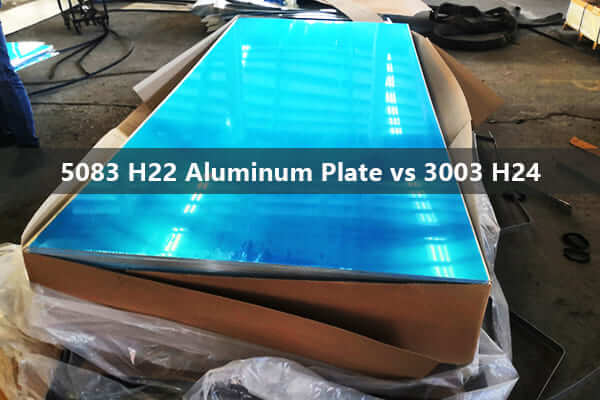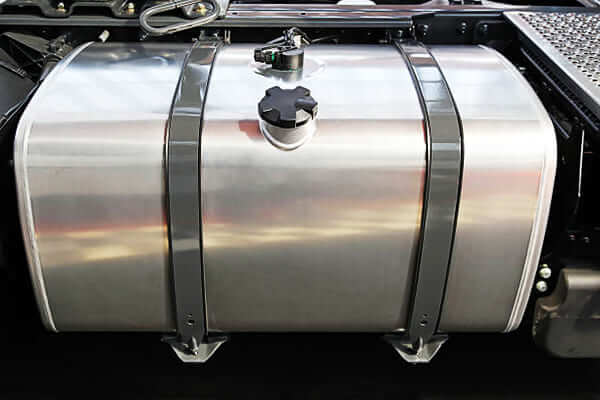Explore the key differences between 5083 h22 aluminum plate vs 3003 h24—from marine‑grade corrosion resistance and high tensile strength to excellent formability and cost efficiency—so you can choose the perfect alloy for your project.
Choosing the right aluminum plate for a project is a critical decision that impacts everything from fabrication ease to long-term durability.
While many alloys look similar, their underlying chemistry and processing create vastly different performance characteristics.
Two common yet distinct choices are 5083 H22 Aluminum Plate vs 3003 H24.
At first glance, they might seem interchangeable for general-purpose work. However, this is a crucial misconception.
One is a high-performance marine-grade powerhouse, while the other is a versatile and formable industry workhorse.
This definitive guide will break down the differences between 5083 H22 Aluminum Plate vs 3003 H24, empowering you with the expertise to select the perfect material for your application’s success.

5083 h22 aluminum plate vs 3003 h24
The numbers in an aluminum designation are not random; they reveal the material’s core identity.
The first digit signifies the principal alloying element, which is the primary driver of its behavior.
The “5” in 5083 places it in the 5xxx series, where magnesium (Mg) is the main alloying element.
Magnesium imparts exceptional strength and, most importantly, outstanding corrosion resistance, especially in saltwater and harsh industrial chemical environments.
Consequently, people often refer to 5083 as a “marine-grade” alloy.
It is designed for toughness and endurance in the most demanding conditions.

Huawei 5083 marine aluminum plate
Conversely, the “3” in 3003 designates it as part of the 3xxx series, with manganese (Mn) as its principal alloying element.
Manganese provides a moderate increase in strength over pure aluminum while retaining excellent formability and workability.
The 3003 H24 aluminum plate is not built for extreme environments but excels in applications requiring extensive shaping, bending, and drawing.
The “H” temper designation tells you how the material has been strain-hardened to achieve its final strength and hardness.
This part is crucial for understanding formability.
Therefore, a 5083 H22 aluminum plate is softer and more ductile than a 3003 H24 aluminum plate.
This might seem counterintuitive since 5083 is the stronger alloy overall, but the temper specifically modifies its workability.
The most effective way to see the differences is with a direct comparison table.
This provides a quick overview before we explore each characteristic in greater detail.
| Feature | 5083-H22 Aluminum Plate | 3003-H24 Aluminum Plate | The Key Takeaway |
| Primary Alloy | Magnesium (Mg) | Manganese (Mn) | The core chemical difference driving all other properties. |
| Strength (Tensile) | High (~305 MPa / 44 ksi) | Medium (~185 MPa / 27 ksi) | 5083 is significantly stronger and more robust. |
| Corrosion Resistance | Excellent, especially in saltwater | Good, for general atmospheric conditions | 5083 is the undisputed champion for marine applications. |
| Weldability | Excellent | Good | Both weld well, but 5083 is prized for high-strength welded structures. |
| Formability | Fair | Excellent | 3003 is much easier to bend, stamp, and draw. |
| Typical Applications | Marine components, pressure vessels, cryogenics | General sheet metal, tanks, kitchen equipment | Reflects their core strengths: toughness vs. versatility. |
| Cost | Higher | Lower | 3003 is the more economical, widely available option. |
The table gives you the “what,” but as an engineer, fabricator, or designer, you need the “why.” Let’s explore these differences in more detail.
The most striking difference is strength. The 5083-H22 plate is substantially stronger than its 3003-H24 counterpart.
With a typical tensile strength around 305 MPa, it can withstand significantly higher stresses and loads.
This isn’t just a number; it translates to real-world durability for structural applications.
In contrast, 3003-H24, with a tensile strength of about 185 MPa, is not designed for high-stress structural roles.
Its strength is perfectly adequate for many applications, but it simply cannot compete with 5083 where load-bearing capacity is paramount.

3003 Diamond Aluminum Plate
This is where 5083 aluminum sheet truly earns its reputation.
The high magnesium content gives it exceptional resistance to corrosion, particularly from saltwater and other harsh industrial chemicals.
This makes it the go-to material for shipbuilding, offshore platforms, and coastal structures.
It maintains its structural integrity where other alloys would quickly degrade.
On the other hand, 3003 aluminum offers good, reliable corrosion resistance in normal atmospheric conditions.
It will perform well for roofing, siding, and general fabrication.
However, it is not recommended for continuous immersion in saltwater, as it lacks the specialized resistance of the 5083 alloy.
Here we see a classic engineering trade-off.
3003-H24 is celebrated for its excellent formability. Its lower strength and inherent ductility mean it can be easily bent, drawn, and stamped into complex shapes without cracking.
This makes it ideal for producing items like cookware, tanks, and intricate architectural panels.
Conversely, the higher strength of 5083-H22 makes it more difficult to form. It requires more force and larger bend radii to prevent cracking.
However, it truly shines in weldability. It produces strong, ductile welds that retain a high percentage of the base metal’s strength, making it perfect for fabricating large, welded structures like pressure vessels and marine hulls.
For many projects, the budget is a primary constraint. 3003-H24 is consistently a more economical and widely available alloy than 5083-H22.
Its widespread use in general manufacturing means mills produce it in large quantities, driving down the cost.
5083-H22 is a more specialized, high-performance alloy. Its production process and raw material costs (higher magnesium content) result in a higher price point.
Therefore, you should only specify 5083 when its superior strength or corrosion resistance is a genuine project requirement.
While the 5083 H22 aluminum plate vs 3003 H24 comparison is a critical one, these two materials don’t exist in a vacuum.
To make a truly informed decision, it’s essential to understand how they stack up against other widely used aluminum alloys.
Placing them on a broader spectrum of performance reveals their unique strengths and clarifies why one might choose them over other popular options like 5052 or 6061.
This comparison will provide you with the context needed to navigate the most common choices in the aluminum plate market.
| Property | 3003 (The Formable Workhorse) | 5052 (The Versatile Bridge) | 5083 (The Marine Powerhouse) | 6061 (The Structural Standard) |
| Primary Use | General fabrication, ductwork, signage | Marine components, enclosures, tanks | Boat hulls, pressure vessels, cryogenics | Machine parts, architectural frames |
| Strength | Low | Medium | High | High |
| Corrosion Resistance | Good | Very Good (Good in saltwater) | Exceptional (Excellent in saltwater) | Good |
| Formability | Excellent | Very Good | Good | Fair |
| Weldability | Excellent | Excellent | Excellent | Good (with strength loss) |
| Heat-Treatable? | No | No | No | Yes |
Your project’s specific needs will point directly to the right material.

5083 h22 aluminum plate for Fuel Tanks
It’s helpful to understand where another popular alloy, 5052, fits in. Think of 5052 aluminum plate as the middle ground.
For a project that needs more strength than 3003 but doesn’t require the full marine-grade performance (and cost) of 5083, 5052 is often the perfect compromise.
The choice between 5083 H22 aluminum plate vs 3003 H24 is a clear decision once you define your priorities.
Ultimately, attempting to substitute the cheaper 3003 H24 in an application designed for 5083 H22 will lead to premature failure.
Conversely, using the expensive 5083 H22 for a simple bracket is over-engineering.
By understanding their core identities, you can now confidently select the right material, ensuring your project is built for performance, durability, and success.
Q1: Can I substitute 3003 H24 for 5083 H22 in a boat repair?
Absolutely not. The 3003 H24 plate will corrode rapidly in a marine environment, compromising the structural integrity of the repair and potentially leading to catastrophic failure.
Always use a certified marine-grade alloy like 5083 or 5052 for marine applications.
Q2: Which plate is easier to bend in a press brake?
The 3003 H24 aluminum plate is significantly easier to bend.
It requires less tonnage and can achieve a tighter bend radius without cracking compared to the stronger and less ductile 5083 H22.
Q3: Why is 5083 H22 so much more expensive than 3003 H24?
The cost difference comes from two main factors: the raw material cost of the alloying elements (magnesium is more expensive than manganese) and the more complex processing and quality control required to produce a high-performance, certified structural plate like 5083.
Cold rolled aluminum strip is a thin strip made of aluminum alloy that is processed by cold rolling. It is widely used in aerospace, automobile manufacturing, building materials and other fields.
5454 aluminum circles have all the properties of 5454 aluminum alloy and are often used in can sealing, non-stick pot bottoms, traffic signs, lampshades, etc.
Aluminum alloy 8011 aluminum foil is widely used in aluminum-plastic composite board base tape and food packaging. As a professional aluminum foil 8011 manufacturer in China, Huawei Aluminum has a large 8011 aluminum foil production base and has accumulated more than 20 years of rich aluminum foil production experience and skilled processing technology.
Our commitment to quality, variety, and customization ensures that you'll find the perfect insulation aluminum coil for your project.
The 3000 series rolled mirror aluminum plate is a premium aluminum product known for its exceptional reflectivity, durability, and versatility. It is widely used in industries where aesthetics and performance are critical.
1060 Aluminum Coil is composed of 99.6% aluminum, which is similar to the 1050 alloy of the same family, but the aluminum content differs by 0.1%.
No.52, Dongming Road, Zhengzhou, Henan, China
Henan Huawei Aluminum Co., Ltd, One Of The Biggest Aluminum Supplier In China Henan,We Are Established In 2001,And We Have rich experience in import and export and high quality aluminum products
Mon – Sat, 8AM – 5PM
Sunday: Closed
© Copyright © 2023 Henan Huawei Aluminium Co., Ltd
Latest Comments
Dear Sir, Please offer your best FOB Prices specs are as under ALUMINIUM STRIP (AL=99.50% MIN) SIZE:450 X32 X6 MM. DIN EN 570 EN-AW 1050 A, QUANTITY=3400KG
Hello, Would you be so kind to offer item as follows: Coil 0,6х1250 (1000)mm EN AW-3105 5tons
Hello, Can you offer me Aluminium plates? Actally I need: 110mm x 1700mm x 1700mm 5083 H111 - 21 pcs Next year planed is 177 pcs
Świetny artykuł. Byłem zachwycony, że wyszukałem ten artykuł. Wielu osobom wydaje się, że mają rzetelną wiedzę na ten temat, ale często tak nie jest. Stąd też moje miłe zaskoczenie. Jestem pod wrażeniem. Zdecydowanie będę rekomendował to miejsce i częściej wpadał, aby zobaczyć nowe rzeczy.
requirement of aluminium strip